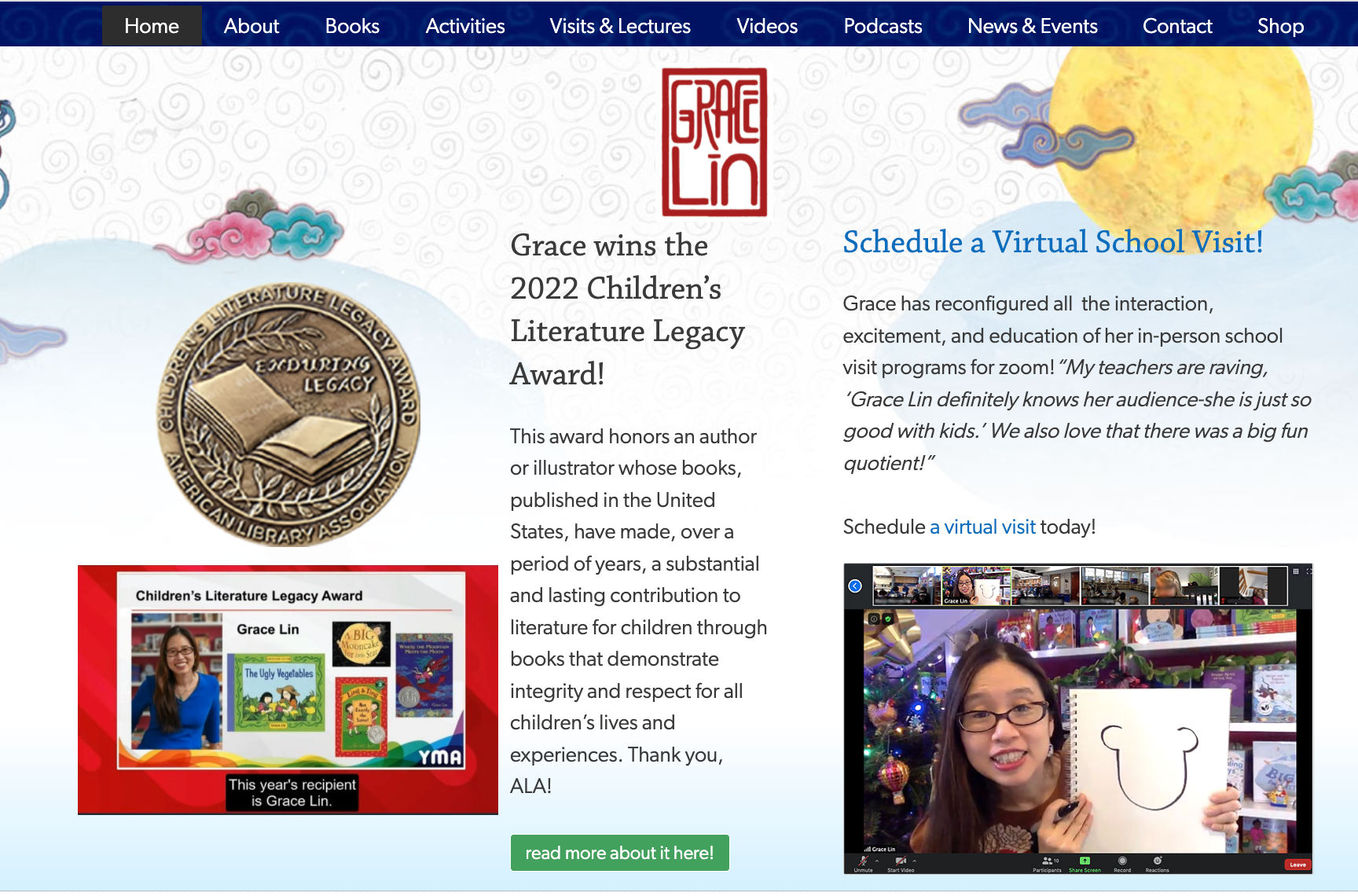On Your Author Website Content

By Christine Carron
I have worked on software development projects for over twenty-five years. First as a business analyst, then as a project manager. There are many moving pieces involved in building a website that satisfies (and ideally exceeds) a client’s expectations, but the one I want to focus on today is content.
Content might not be as fun as design (i.e., how a website looks). Nor as exciting as functionality (i.e., what a website does.) But when I work with clients, one of the first exercises we always work through is a content readiness plan. Let's look at why . . .
Why Content Rules
Though design, functionality, and content are all important, content actually impacts design and functionality. In that sense content is king, or queen, or whatever royal designation you prefer.
Imagine we have two authors who want to get new websites up and, of course, both want a page on the site that features their book(s). Which means, to be super clear, their books are part of their content.
One of our authors, though, is a debut young adult (YA) author whose first book is about to be published. The other author is an established children’s book author with fifty published books spanning picture books to YA.
A simple page that could grow to hold a few books would be a reasonable design option for the debut young adult author. But any designer worth their chops would come up with a completely different design (and functionality) for our established writer.
Think about it: If you were visiting a writer’s site, would you want to scroll down a single page that had fifty books listed with no way to filter them? I wouldn’t. That would be an awful design solution.
This is just one way content can impact design and functionality. And now that you have a better idea on why thinking through content early in the process is so important, let’s move to a process that can help you do that.
Goodjelly’s Content Readiness Plan
Step #1: Brainstorm
Step #1a: Initial Brain Dump
Make a list of the content you want (or think you should have) on your author website. You may initially focus on what you envision as the different pages of your website. That is fine. For example, your starting content list may include:
- Homepage
- Bio
- News
- Events
- Resources
- Contact
- Blog
Step #1b: Conduct an Author Website Survey
Once you have your initial content list, refine/add to it by researching other author websites. If you are a debut or pre-published author, be sure to find author websites for newly published authors as well as your favorite big-name authors. I recommend checking out at least ten different author websites.
Look for content they have in common and look for content that is unique that sparks your interest. Update your initial list as needed. (You might remove some items. You might add some items.)
Bonus tip: When you are looking at other author websites also note any functionality, visual elements, or copy (tone/style) that you like. Since you are looking, you may as well copy ideas that will help you later in your design process. Be sure to capture the URL of pages for the items you note, so you can easily find them again.
Step #1c: Consider Audiences
In this step, you continue to refine your content list by considering the various audiences you want to reach. In technical lingo, these are sometimes referred to as personas or user types.
All websites have a "general visitor" type. But you can also create content for specific audience subsets. To help you get an idea of how that works, I did a high-level analysis of kidlit writer Grace Lin's author website to identify specific audiences and the types of content associated with each:
- All Visitors/Fans: Books; About Grace (The About Menu item also has other sub-pages: Family, FAQ, Fun Facts); News & Events; Shop (redirects to Ms. Lin’s Etsy page)
- Schools/Teachers: the Book School Visit CTA on the Homepage; School Visits page; Videos for Educators page
- Women Kidlit Authors: kidlitwomen* Podcast
- Kidlit Community: Book Friends Forever Podcast
- Young Readers: Kids Ask Authors Podcast; Videos for Kids ; Activities
As you can see, thinking through various audiences can create specific content possibilities.
That said, don’t panic or think you have to have as many audiences or as much content as Ms. Lin. Start with the content you have and want, and go from there. I suspect the content on the first iteration of Ms. Lin’s author website was not nearly as extensive.
Bottom line: You want a website that works for where you are now, and gives you some growing room.
Step #2: Categorize
Once you have your refined list of content possibilities, group your potential content into two buckets based on what type of content it is: Static or Dynamic.
Static content is content that rarely changes like your bio, or an FAQ page, or a Resources page.
Dynamic content is content that changes. It is useful because it helps drive website engagement, i.e., people coming back for more.
Dynamic content can be recurring in nature, i.e., content you produce and post on a regular basis like a blog or a podcast. It can also be more intermittent in nature, like content for a News page or and Events page. Or it can be feature-based, like a CTA.
A CTA (Call to Action), is any invitation for visitors to take action on your website. They can also be strategically used to create quick access to a particular page.
For example, Ms Lin has two CTAs on her author site homepage (image captured 08-Feb-2022):

The CTA on the left invites a site visitor to learn more about Ms. Lin's recent award. That is a feature-based CTA.
The one on the right makes it easy for schools to book Ms. Lin for virtual school visits. That is a quick-access CTA, meaning instead of having find the school visit page using the navigation and multiple clicks, a teacher who wants to book Ms. Lin can get directly to that page easy-peasy.
Step #3: Prioritize Your Content Possibilities
When you are considering website content, you want to be realistic about what is a must-have and what is nice-to-have. For example, static content for an About me/Bio page is a must-have. A blog on your author website likely not so much.
On that note, definitely be careful with your prioritizations around dynamic content. If you create an Events page, you have to hustle to get the events. If you create News page, you are going to have to generate News.
If, instead, you create pages for dynamic content (or even static content) but have no plan for creating the needed content, you will end up with empty pages or promises on your website—such as pages that have “Coming Soon” on them for months or years, or a blog that a writer only adds a post to once or twice a year. That can disappoint or frustrate your site visitors.
It also might create an optics problem. For example, while researching sites for this post, I visited one author’s page whose last listed event was in 2012. That doesn't look good from a branding perspective.
Bottom line: Prioritize content that you can commit to creating. You can grow into other content as needed.
Step #4: Draft the Copy
Content can include copy, images, pdfs, videos, etc., but for this step I want to focus in on the copywriting part.
First, draft your static content/copy. After you have your static content drafted, move to any specific recurring content. A needed foundational step for recurring content is to decide basic parameters for the content. If you are planning a blog, for example, decide:
- how often you will post
- the average post length
- what is the purpose of your blog
- which of your audiences is your blog targeted to
- how/if you will source images for each post and if so where will you source your images so as not to infringe upon copyright laws
Once you have all the above sorted, draft at least two blog posts. This gives you a sense of the time it will take to generate a post and if your posting rhythm is realistic.
If you deem a blog (or any other recurring content) not feasible from a commitment perspective after your mini trial run, launch your author website without it. It is totally not required. You can add one later if you want it.
Bottom line: Keep things simple to start.
When you create your author website copy before building the site (or hiring a designer) you have a huge chunk of the work done that is required for the website. Huge. You will also hone in on the tone and style of your copy, which can feed into your creative process with design.
Content Clarity Builds Confidence
When you follow this Content Readiness Plan (Brainstorm, Categorize, Prioritize, Draft) and get clarity on your content before you start building your website, I guarantee you will have more confidence making design and functionality decisions about your author website. Sure there will be a lot of work left to do, but you will have a rock solid foundation for building an author website that rules. Sweet!
The Goodjelly Prompts of the Week
- Post-in-Action Prompt: Get cracking on preparing your author website content. You have the steps. Make it happen. You have got this!
- Scene Prompt: Write a scene where your character has to do something that is a little outside their comfort zone. Let them get into it and be surprised when it turns out to be more fun than they expected.
- Journaling Prompt: If you already have an author website, what do you love about it? What would you like to change? If you don’t have an author website yet, what scares you about creating one? What excites you about creating one?
- Connection Prompt: Connect with your writerly peeps discuss/share favorite author websites to spark content possibilities.
Don't miss a single dollop of Goodjelly
Subscribe for the Latest Blog Posts & Exclusive Offers!
You can easily unsubscribe at any time.


